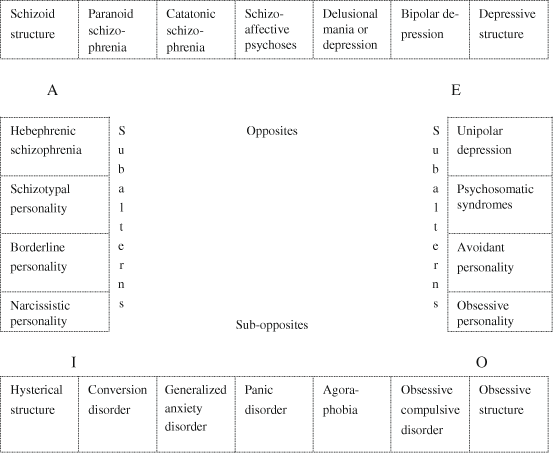Fig. 2.1
Polar structuration of the psychotic and non-psychotic syndromes

Fig. 2.2
Fundamental psychopathological structures and their relation to common psychiatric syndromes (cf. Doerr-Zegers 1987)

Fig. 2.3
Aristotle’s square of oppositions
Such a resolution deals with a strange case of isomorphism between the logical structure of judgment and the forms through which that psychopathological region of reality is disclosed to us. This scheme allows us to distinguish between contrary (schizophrenic and depressive, hysterical and obsessive) and contradictory (depressive and hysterical, schizophrenic and obsessive) structures. There are transitions between the contraries and not between the contradictions. Regarding the contradictions and excluding the character of hysteria and depression, I refer to the interesting works of Alfred Kraus (1977, 1987) and in reference to another dyad (i.e., schizophrenic versus obsessive structure), to an enlightening work carried out by Hermann Lang (1985).
These structures are not simple reifications as is the case for categorical diagnoses, but “ideal” types, in the sense of Jaspers (1997, p. 560). For Jaspers, “dialectics is the form in which a basic aspect of meaningful connections becomes accessible to us” (1997, p. 345) and that is also precisely a structure in the style of the ones we are describing. The ideal types are for Jaspers always self-evident; they do not lead to theories but rather correspond to patterns through which particular events can be measured (1997, p. 357). Hence, Riemann (1975) described these same four structures from the perspective of the different forms of anxiety that characterize them. We, as well, have attempted in other works (Doerr-Zegers 1987) to do something similar, but from the point of view as to how temporality, spatiality and interpersonality are experienced as given to the person (especially as to how he experiences these in a bodily way).
To show what is depressive as polar with respect to what is schizophrenic, or what is obsessive with respect to what is hysterical is more than a semantic game or a mere theoretical digression. By seeing one as the positive side of the other and vice versa, we widen our capacity for understanding , prejudices are eliminated with respect to the supposed negativity of one or the other condition and a privileged way of therapeutic action is opened up to us. In order to avoid a mere adaptation to that non-existent “average” state of being, one must attempt to make the patient aware of the positivity of his supposedly “abnormal” features or symptoms, but in such a way that he begins a journey in the opposite direction toward the opposite pole. By doing so, he can approach the Greek notion of moderation because, as the old wisdom by Heraclitus says:
(In the end) cold becomes warm, warm becomes cold,humid becomes dry and dry becomes humid. (Fragment No. 126)
2.3 Hermeneutics, Dialectics and Psychiatry
We have outlined some aspects of the relationship between hermeneutics and psychiatry and also between psychiatry and dialectics . We have underlined that hermeneutics already appears essential in the first encounter with the patient, both in its pre-verbal moment and in the verbal one. We have also pointed out the advantages that the dialectic perspective offers in psychiatry and how it is better adapted to the richness and complexity of psychopathological phenomena than other ways of thinking, for example, causal and linear ones.
Now the question arises: which relationship exists between phenomenology, hermeneutics and dialectics , and then between all of them and psychiatry?
Wiehl (1970) states that the relationships between phenomenology, dialectics and hermeneutics can be better understood if one starts from the concepts of theory and method. Thus, phenomenology is undoubtedly more a method than a theory, while dialectics is perhaps both at the same time; it even demands a dynamic (dialectic) unity between theory and method. Hermeneutics, in turn, is neither a theory nor a method, but something like an original understanding , which can allow one to distinguish between and establish the dialectic relationship between theory and method. As Jaspers says, the world as a whole is to a certain extent opened to hermeneutic understanding. We could add that one of the first perceptions resulting from this attitude is the dialectic structuring of reality. The distinction between theory and method appears as one of those dialectic structures. Phenomenology, hermeneutics and dialectics can be distinguished from any other form of theory because of their absolute reference to what is originary and primordial.
Stay updated, free articles. Join our Telegram channel

Full access? Get Clinical Tree



